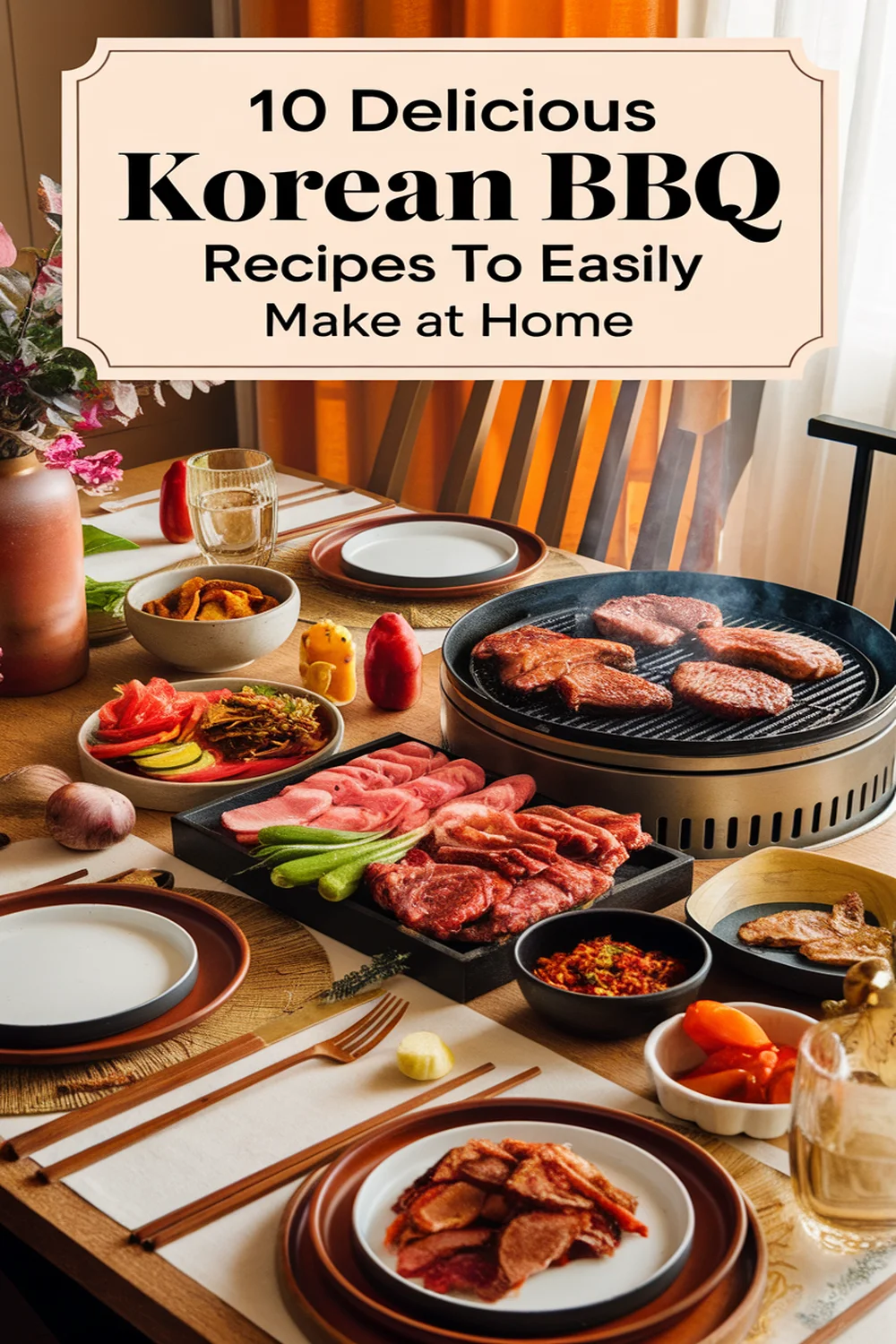This post may contain affiliate links. Please read our policy page.
If you want to savor the flavors of Korea at home, try these 10 delicious BBQ recipes! Start with tender bulgogi and spicy pork belly, then grill marinated chicken or savor savory garlic butter shrimp. Complement your meal with comforting sides like corn cheese, kimchi stew, and seaweed salad. Don’t forget the sweet and spicy ssamjang dipping sauce for a perfect bite. Keep exploring for even more mouthwatering dishes and tips to elevate your Korean BBQ experience!
Classic Korean BBQ Beef (Bulgogi)
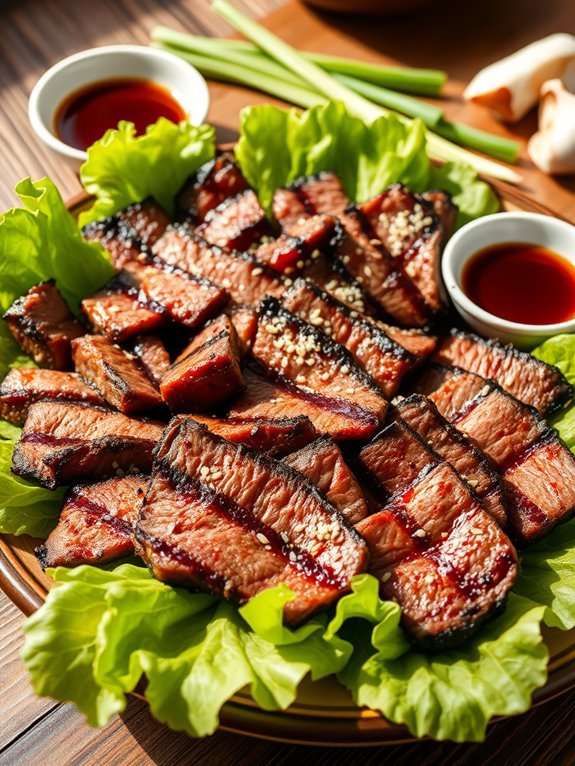
Bulgogi, a traditional Korean BBQ dish, is beloved for its tender, marinated beef that’s grilled or stir-fried to perfection. The term “bulgogi” translates to “fire meat”, reflecting the dish’s cooking method and vibrant flavors. Typically made with thin slices of beef, this delicious preparation is enhanced with a savory marinade that combines soy sauce, sugar, sesame oil, and garlic, making it both sweet and savory. Whether enjoyed on its own or wrapped in lettuce with a dollop of ssamjang (a thick, spicy sauce), bulgogi offers a delightful taste of Korean cuisine.
Cooking bulgogi isn’t only simple but also a true feast for the senses. The fragrant marinade seeps into the meat, tenderizing it while imparting a delicious umami flavor. You can cook bulgogi on a grill, hot plate, or even a skillet at home, making it a versatile option for gatherings and weeknight dinners alike. As you cook, the beef caramelizes slightly, creating a mouthwatering appearance and aroma that’s sure to impress your family and friends.
Ingredients:
- 1 pound beef ribeye or sirloin, thinly sliced
- 4 tablespoons soy sauce
- 2 tablespoons brown sugar
- 1 tablespoon sesame oil
- 2 cloves garlic, minced
- 1 teaspoon ginger, grated
- 1/4 teaspoon black pepper
- 3 green onions, chopped
- 1 tablespoon sesame seeds (optional)
- Lettuce leaves for wrapping (optional)
To prepare the bulgogi, mix the soy sauce, brown sugar, sesame oil, garlic, ginger, black pepper, and green onions in a bowl. Add the thinly sliced beef, guaranteeing that all pieces are well-coated in the marinade. Cover the bowl and let the beef marinate in the refrigerator for at least 30 minutes, or up to overnight for deeper flavor.
Heat a grill pan or skillet over medium-high heat and cook the marinated beef for about 3-5 minutes, or until it’s nicely caramelized and cooked through. Serve hot with lettuce leaves and sesame seeds, if desired.
For best results, a few tips can elevate your bulgogi experience. Confirm that the beef is sliced against the grain for maximum tenderness; freeze it slightly before slicing to make cutting easier. If you’re short on time, you can marinate the beef for just 30 minutes, but longer marination is worth the wait for richer flavors.
Don’t overcrowd the pan or grill; cook in batches if necessary to avoid steaming the meat. Finally, adjusting the sweetness or spice levels in the marinade to suit your taste can make this dish truly yours. Enjoy the delightful experience of sharing bulgogi, embracing the communal spirit of Korean BBQ!
Spicy Pork Belly (Daeji Bulgogi)
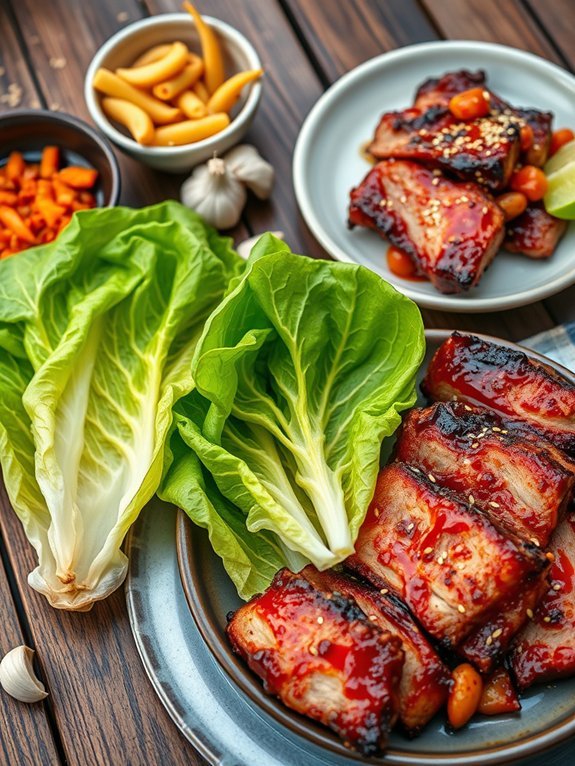
Spicy Pork Belly, or Daeji Bulgogi, is a fiery and flavorful staple in Korean BBQ cuisine. The dish showcases tender slices of pork belly marinated in a spicy and savory blend of Korean ingredients, resulting in a mouthwatering meal that’s perfect for grilling. Traditionally served with a variety of side dishes and wrapped in lettuce leaves, Daeji Bulgogi brings a satisfying mix of textures and flavors. It can be enjoyed with steamed rice, kimchi, or even in a spicy Korean taco for a fusion twist.
Preparing Daeji Bulgogi at home can be a delightful experience. The key to a great marinade is balancing the spice level to suit your taste preferences while enhancing the rich flavor of the pork.
Once marinated, the pork belly can be grilled to crispy perfection, allowing the smoky char from the grill to complement the spices. This dish is sure to impress family and friends alike at any gathering or barbecue.
Ingredients:
- 1 lb pork belly, thinly sliced
- 3 tablespoons gochujang (Korean red chili paste)
- 2 tablespoons gochugaru (Korean red chili flakes)
- 2 tablespoons soy sauce
- 1 tablespoon sugar
- 1 tablespoon sesame oil
- 4 cloves garlic, minced
- 1 teaspoon ginger, grated
- 1 tablespoon green onions, chopped
- 1 tablespoon sesame seeds (optional)
To make the marinade, combine gochujang, gochugaru, soy sauce, sugar, sesame oil, garlic, ginger, and green onions in a large mixing bowl. Mix until smooth and well combined.
Add the thinly sliced pork belly to the marinade, ensuring each piece is thoroughly coated. Cover the bowl with plastic wrap and let it marinate in the refrigerator for at least 30 minutes, or preferably 2 hours for deeper flavor.
Preheat a grill or skillet over medium-high heat and cook the marinated pork belly pieces for about 3-4 minutes on each side, or until nicely charred and cooked through.
For the best results, be sure not to overcrowd the pan or grill when cooking, as this can lead to steaming rather than caramelization.
If you’re using a grill, consider soaking wooden skewers in water for about 30 minutes before threading the marinated pork onto them, which helps prevent burning.
Additionally, serve your Daeji Bulgogi with an assortment of banchan (Korean side dishes) like pickled radish and lettuce for wrapping, enhancing the overall dining experience.
Marinated Grilled Chicken (Dak Bulgogi)
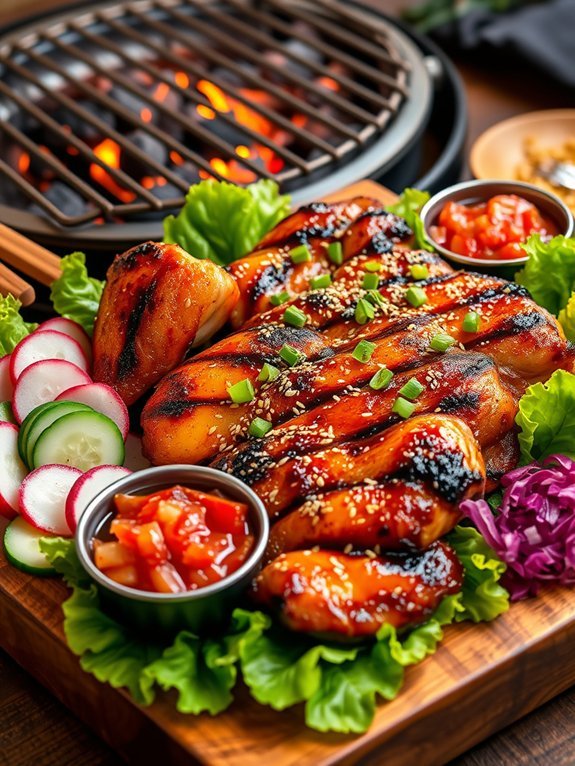
Dak Bulgogi is a popular Korean grilled chicken dish that’s marinated in a sweet and savory sauce, making it incredibly flavorful and perfect for gatherings or weeknight dinners. The marinated chicken is typically cooked on a grill, enhancing its smoky flavor and resulting in a beautifully caramelized exterior. This dish not only showcases the rich flavors of Korean cuisine but also provides a delightful and delicious option for anyone looking to enjoy a hearty meal that’s quick and easy to prepare.
When making Dak Bulgogi, the balance of spices in the marinade is key to achieving the authentic taste associated with traditional Korean BBQ. Ingredients such as soy sauce, garlic, ginger, and sesame oil sing together in harmony, infusing the chicken with mouthwatering flavors.
Whether served with rice, lettuce wraps, or a side of kimchi, this dish is sure to impress your family and friends while satisfying your craving for delicious grilled chicken.
Ingredients:
- 1 lb boneless chicken thighs or breasts, thinly sliced
- 4 tablespoons soy sauce
- 2 tablespoons sugar
- 2 tablespoons sesame oil
- 2 tablespoons minced garlic
- 1 tablespoon minced ginger
- 1 tablespoon gochugaru (Korean red pepper flakes) or to taste
- 2 teaspoons sesame seeds
- 2 green onions, finely chopped
- Freshly ground black pepper to taste
Marinate the chicken in a mix of soy sauce, sugar, sesame oil, minced garlic, minced ginger, gochugaru, sesame seeds, green onions, and black pepper for at least 30 minutes, although overnight marination is preferred for deeper flavor.
Preheat a grill or non-stick skillet over medium-high heat. Cook the marinated chicken for about 5-7 minutes on each side or until fully cooked and slightly charred. Verify the chicken reaches an internal temperature of 165°F (75°C).
For the best results, make certain not to overcrowd the grill, as this can cause the chicken to steam instead of grill, preventing it from achieving that desirable charred texture. Additionally, feel free to customize the level of heat in the marinade by adjusting the amount of gochugaru to suit your taste preferences.
Serve Dak Bulgogi with a side of fresh vegetables or steamed rice to complement the flavors, and enjoy a delicious Korean BBQ experience right at home!
Savory Garlic Butter Shrimp
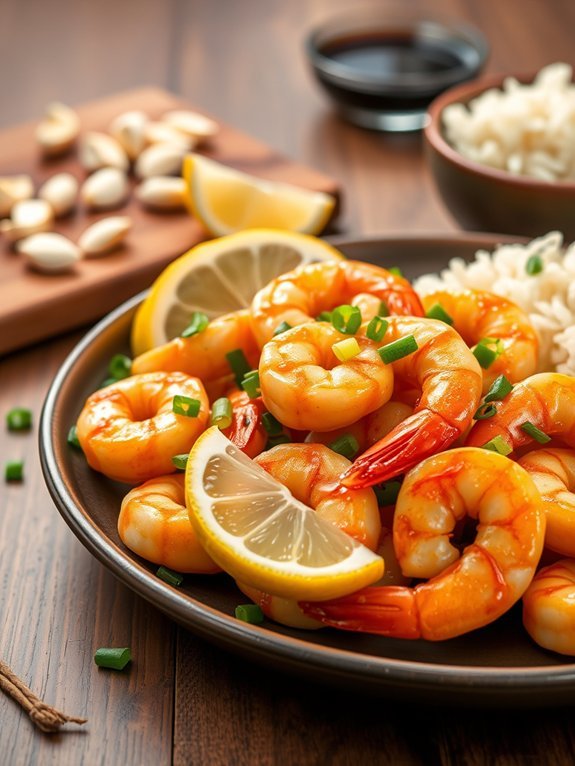
Savory garlic butter shrimp is a delightful dish that epitomizes the flavors of Korean BBQ while adding a touch of indulgence with rich butter and aromatic garlic.
This recipe showcases plump shrimp sautéed in a mouthwatering garlic butter sauce that perfectly coats each bite in a glaze of savory goodness. Ideal for a cozy family dinner or a festive gathering, this dish pairs wonderfully with steamed rice and a side of grilled vegetables.
The beauty of savory garlic butter shrimp lies not only in its incredible taste but also in its simplicity. With minimal ingredients and a quick cooking time, it’s the perfect dish for those busy weeknights when you want something flavorful but don’t have too much time to spend in the kitchen.
Before you know it, your taste buds will be dancing with joy as you enjoy this delectable creation.
- 1 pound large shrimp, peeled and deveined
- 4 tablespoons unsalted butter
- 4 cloves garlic, minced
- 2 tablespoons soy sauce
- 1 tablespoon honey or brown sugar
- 1 teaspoon red pepper flakes (optional)
- Salt and pepper to taste
- Chopped green onions for garnish
- Lemon wedges for serving
In a large skillet, melt the unsalted butter over medium heat. Add the minced garlic and sauté for about 30 seconds until fragrant. Then, toss in the shrimp and cook for 2-3 minutes on each side until they turn pink and opaque.
Add the soy sauce, honey (or brown sugar), red pepper flakes, salt, and pepper to the skillet, stirring to coat the shrimp evenly. Continue cooking for another minute until the sauce thickens slightly. Garnish with chopped green onions and serve with lemon wedges on the side.
When cooking savory garlic butter shrimp, it’s important not to overcook the shrimp as they can become rubbery.
Also, feel free to customize this recipe by adding your favorite vegetables, such as bell peppers or snap peas, which can be sautéed alongside the shrimp. Adjust the amount of red pepper flakes according to your spice preference for a milder or spicier kick.
Enjoy this dish fresh for the best flavor experience!
Soy Sauce Braised Short Ribs (Galbi Jjim)
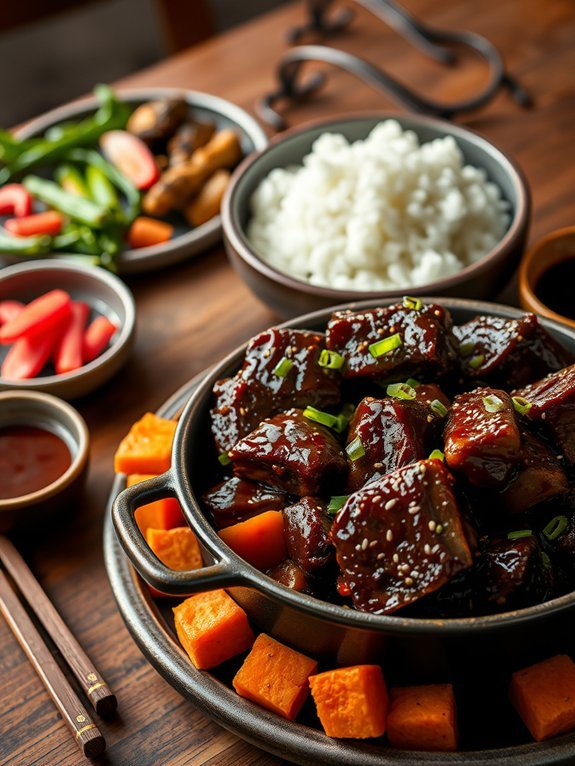
Soy Sauce Braised Short Ribs, or Galbi Jjim, is a classic Korean dish that showcases the rich flavors of tender beef short ribs braised in a savory soy sauce marinade. This dish is often served during special occasions and gatherings, embodying a sense of warmth and comfort.
The combination of sweet and savory flavors, along with tender meat that falls off the bone, makes Galbi Jjim a perfect centerpiece for any meal. Preparing Galbi Jjim may seem intimidating at first, but with a bit of patience and the right ingredients, you can create a dish that will impress your family and friends.
The key to achieving ideal flavor lies in the marination process, which allows the meat to absorb the delightful notes of garlic, ginger, and sesame oil. Once cooked to perfection, this dish pairs beautifully with steamed rice and banchan (Korean side dishes).
Ingredients:
- 2 lbs beef short ribs
- 1 cup soy sauce
- 1/2 cup brown sugar
- 1/4 cup garlic, minced
- 1 medium onion, sliced
- 1-inch piece ginger, minced
- 1/4 cup sesame oil
- 2 cups water
- 2 medium carrots, cut into chunks
- 3 green onions, chopped
- Sesame seeds, for garnish
To prepare the dish, soak the short ribs in cold water for about 30 minutes to remove excess blood and impurities, then drain and pat dry.
In a large pot, combine soy sauce, brown sugar, garlic, onion, ginger, sesame oil, and water; bring to a simmer. Add the short ribs to the pot and cook on low heat for about 1.5 to 2 hours until the meat is tender. During the final 30 minutes of cooking, add the carrots and remove the lid to help reduce the sauce, allowing it to thicken.
Garnish with green onions and sesame seeds before serving. For ideal flavor, consider marinating the short ribs in the soy sauce mixture for several hours or even overnight prior to cooking. This allows the ingredients to penetrate the meat, enhancing the overall taste.
Additionally, feel free to customize the vegetables by adding mushrooms or potatoes for extra texture and flavor. Lastly, remember that cooking times can vary; adjust based on the thickness of the ribs and desired tenderness. Enjoy your delicious Galbi Jjim!
Recommended Items
Get ready to elevate your home cooking with these must-have ingredients and tools for delicious Korean BBQ!
Grilled Vegetable Skewers
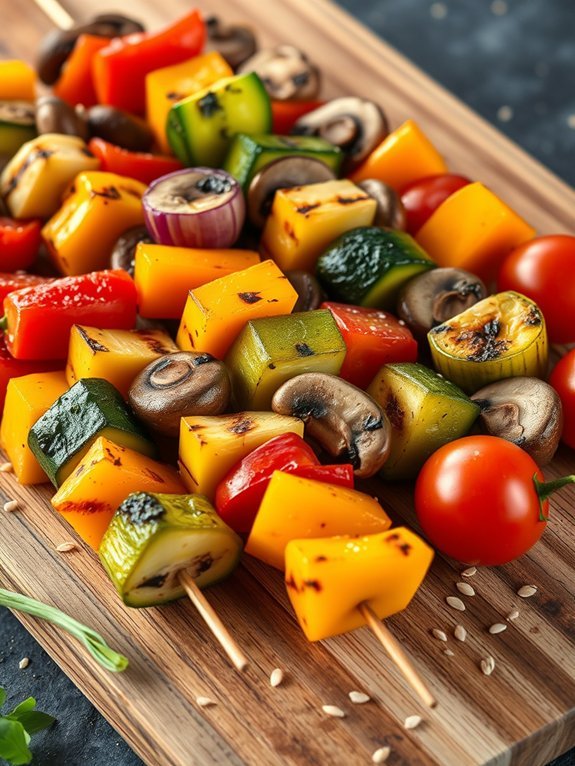
Grilled vegetable skewers are a delightful addition to any Korean BBQ spread, offering a fresh and colorful contrast to the rich and savory flavors of marinated meats. These skewers aren’t only a great way to incorporate more vegetables into your meal but also allow for creative freedom in choosing a variety of colorful produce to suit your taste.
The smoky, charred flavor imparted by the grill enhances the natural sweetness of the vegetables, making them a crowd-pleaser among vegetarians and meat-lovers alike.
Preparing vegetable skewers is simple and quick, making them an excellent option for a busy weeknight dinner or an outdoor gathering. The key is to select sturdy vegetables that hold up well on the grill, such as bell peppers, zucchini, and mushrooms.
To elevate the flavors even further, marinating the vegetables before skewering can infuse them with aromatics and spices that complement the savory notes of a traditional Korean BBQ.
- Bell peppers (red, yellow, or green), cut into chunks
- Zucchini, sliced
- Red onion, cut into wedges
- Cherry tomatoes
- Mushrooms (such as button or shiitake), cleaned and whole
- Olive oil
- Soy sauce
- Garlic, minced
- Sesame oil
- Black pepper
- Skewers (wooden or metal)
In a mixing bowl, combine the olive oil, soy sauce, minced garlic, sesame oil, and black pepper to create a marinade. Add the prepared vegetables to the bowl and toss to confirm they’re evenly coated.
Cover and let them marinate for at least 30 minutes while you preheat the grill. Thread the marinated vegetables onto skewers, alternating between different types for a visually appealing presentation.
Grill the skewers over medium-high heat for approximately 10-15 minutes, turning occasionally, until they’re tender and slightly charred.
When grilling vegetable skewers, be cautious of overcooking, as some vegetables can become mushy if left too long on the heat. If you’re using wooden skewers, be sure to soak them in water for at least 30 minutes prior to grilling to prevent them from burning.
Feel free to experiment with different vegetables and add-ins like tofu or even fruits like pineapple for a touch of sweetness. Serve these skewers hot off the grill with a sprinkle of sesame seeds or green onions for added flavor and presentation.
Step-by-Step Cooking Guide
Korean-style Corn Cheese

Korean-style corn cheese is a delightful and comforting dish that perfectly blends the sweetness of corn with rich cheese, making it a favorite among many. Often enjoyed as a side dish during a Korean BBQ meal or as a delicious snack, this dish is incredibly simple to prepare and requires minimal ingredients. The gooey, melted cheese combined with the tender corn creates an irresistible combination that’s bound to please anyone at your table.
To create the perfect corn cheese, you’ll want to guarantee that your ingredients are fresh and ready to go. While this dish is traditionally made with canned corn, using fresh or frozen corn can elevate its flavor and texture. As it cooks, the corn takes on a beautiful roasted taste while becoming enveloped in a creamy, cheesy layer that’s both satisfying and indulgent.
It’s the ideal accompaniment to grilled meats or can simply be enjoyed on its own with a side of crispy chips.
- 1 can (15 oz) sweet corn, drained
- 1 cup shredded mozzarella cheese
- 1/2 cup mayonnaise
- 1 tablespoon sugar
- 1/2 teaspoon salt
- 1/4 teaspoon black pepper
- 1 tablespoon chopped green onions (for garnish)
- Optional: 1/4 cup grated Parmesan cheese
In a mixing bowl, combine the drained corn with mayonnaise, sugar, salt, black pepper, and half of the mozzarella cheese. Stir until all the ingredients are well mixed.
Pour the mixture into a baking dish and top it with the remaining mozzarella cheese (and optional Parmesan cheese if desired). Bake in a preheated oven at 375°F (190°C) for 15-20 minutes or until the cheese is bubbly and golden brown. Garnish with chopped green onions before serving.
For an added depth of flavor, consider incorporating diced jalapeños or chopped kimchi into the corn mixture before baking to give it a spicy twist.
You can also experiment with different kinds of cheese to find your perfect blend. If serving as a side dish, offer crispy tortilla chips or fresh vegetables for dipping to complement the creamy corn cheese.
Spicy Kimchi Stew (Kimchi Jjigae)
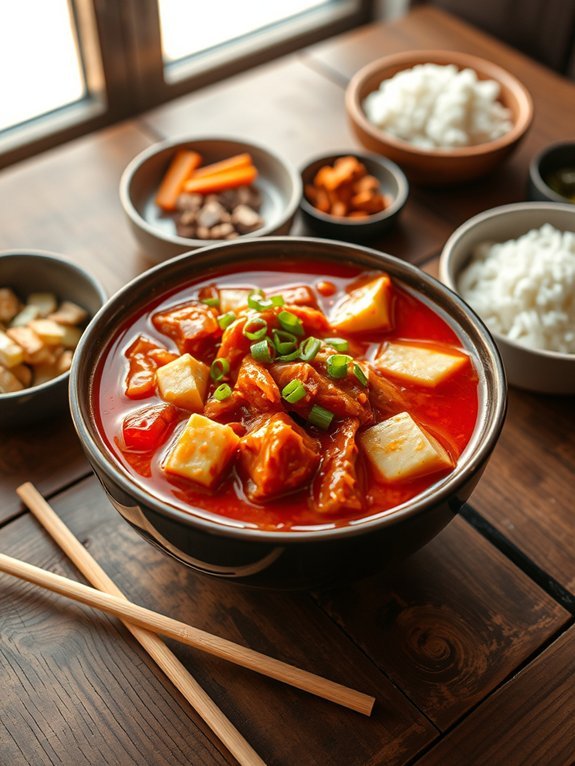
Spicy Kimchi Stew, or Kimchi Jjigae, is a beloved traditional Korean dish that brings warmth and heartiness to the table. This savory stew showcases the bold flavors of fermented kimchi, making it a perfect comfort food, especially during colder months or when you’re in need of something hearty. Packed with protein sources like tofu and a choice of meats, this dish not only warms you up but also fills you up.
Making Kimchi Jjigae is straightforward and can be customized according to your taste preferences or ingredient availability. The depth of flavor in this stew comes from the simmering of kimchi, which releases its tangy and spicy essence into the broth, creating an irresistible aroma. Ideal for a quick weeknight dinner, this stew pairs perfectly with a bowl of steamed rice for a satisfying meal.
- 2 cups ripe kimchi (chopped)
- 1 cup pork belly or beef (sliced thinly)
- 1 block of firm tofu (cubed)
- 4 cups of water or broth
- 1 onion (sliced)
- 2 green onions (chopped)
- 2 tablespoons gochugaru (Korean red pepper flakes)
- 1 tablespoon soy sauce
- 1 tablespoon sesame oil
- 1 teaspoon minced garlic
- Salt to taste
In a large pot, heat the sesame oil over medium heat and add the sliced pork belly or beef. Cook until the meat is browned, then add the chopped kimchi and onion. Stir-fry for a few minutes until the kimchi is slightly softened.
Pour in the water or broth and bring to a boil. Reduce the heat, add the gochugaru, soy sauce, garlic, and tofu, then let simmer for about 20 minutes. Towards the end of cooking, stir in the green onions and adjust seasoning with salt if needed.
For a spicier stew, consider adding more gochugaru or even some sliced fresh chili peppers. Additionally, using well-fermented kimchi will enhance the overall flavor of the stew—so don’t hesitate to use kimchi that has been sitting for a while.
If you’re looking for a vegetarian version, you can substitute the meat with mushrooms and add a splash of soy sauce for that umami flavor. Pair your stew with a side of rice and banchan (small side dishes) for a complete Korean meal experience.
Seaweed Salad (Miyeok Muchim)
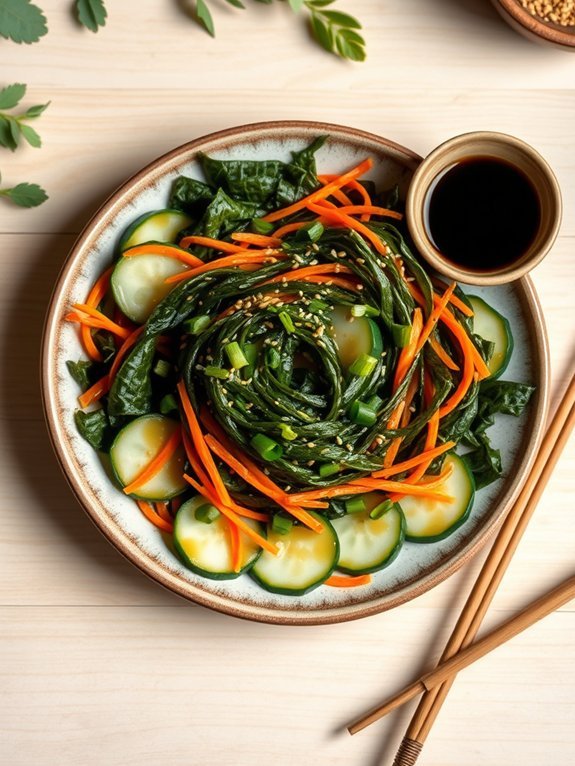
Seaweed salad, known as Miyeok Muchim in Korean cuisine, is a flavorful and nutritious dish that highlights the umami of seaweed, bringing a unique taste to any table. This salad isn’t only delicious but also packed with essential vitamins and minerals, making it a perfect accompaniment to a Korean BBQ meal or a stand-alone salad.
The simple ingredients come together to create a revitalizing dish that balances well with the rich flavors of grilled meats.
Preparing Miyeok Muchim is quick and easy, allowing you to enjoy this delightful salad without much fuss. Typically made with dried seaweed, the salad can be customized with various vegetables, sesame seeds, and a tangy dressing, which elevates the flavors even further.
Whether you’re serving it for a casual dinner or a special occasion, this seaweed salad is bound to impress your guests and satisfy your cravings for something light but flavorful.
- 1 cup dried wakame seaweed
- 1 medium cucumber, thinly sliced
- 1 small carrot, julienned
- 2 tablespoons soy sauce
- 1 tablespoon rice vinegar
- 1 tablespoon sesame oil
- 1 tablespoon sugar
- 1 teaspoon sesame seeds
- 1 teaspoon minced garlic (optional)
- Chopped green onions (for garnish)
Soak the dried wakame seaweed in warm water for about 10-15 minutes until it expands and softens, then drain and chop into bite-sized pieces. In a medium bowl, combine the seaweed, cucumber, and carrot.
In a separate small bowl, whisk together soy sauce, rice vinegar, sesame oil, sugar, and minced garlic (if using). Pour the dressing over the salad mixture and toss gently to coat evenly.
Sprinkle sesame seeds on top, and garnish with chopped green onions before serving.
When preparing Miyeok Muchim, be sure to adjust the dressing to your personal taste; you can add more vinegar for tanginess or more sugar for sweetness. Additionally, if you’re using fresh ingredients, try to select high-quality seaweed, as the flavor can greatly impact the dish.
For extra texture, consider adding sliced radishes or bell peppers, as these will contribute a nice crunch to the salad. Enjoy experimenting with different ingredients to make the dish your own!
Sweet and Spicy Korean Dipping Sauce (Ssamjang)

Sweet and Spicy Korean Dipping Sauce, known as Ssamjang, is a rich and flavorful condiment that enhances the enjoyment of Korean BBQ. This versatile sauce combines the savory depth of doenjang (fermented soybean paste) with the sweetness of gochujang (Korean chili paste), creating a delightful balance of flavors.
Perfect for dipping grilled meats or slathering over fresh lettuce wraps, Ssamjang will elevate your barbecue experience to a whole new level.
Making Ssamjang at home is simple and requires only a handful of ingredients. The blend of ingredients can be easily adjusted to suit your taste preferences, whether you prefer it sweeter or spicier. This recipe will provide you with a delightful dipping sauce that captures the essence of Korean cuisine, making it a must-have for any BBQ gathering.
- 2 tablespoons doenjang (fermented soybean paste)
- 2 tablespoons gochujang (Korean chili paste)
- 1 tablespoon honey or brown sugar
- 1 tablespoon sesame oil
- 1 tablespoon rice vinegar
- 1 teaspoon minced garlic
- 1 teaspoon sesame seeds
- 2 teaspoons finely chopped green onions
In a mixing bowl, combine the doenjang, gochujang, honey or brown sugar, sesame oil, rice vinegar, minced garlic, and sesame seeds. Stir the ingredients together until well combined and smooth.
Adjust the flavors to your liking by adding more honey for sweetness or more gochujang for heat. Finally, fold in the chopped green onions for added freshness and flavor.
When making Ssamjang, feel free to experiment by adding ingredients like a splash of soy sauce or a teaspoon of grated ginger to enhance the flavor profile further. The beauty of this dipping sauce lies in its flexibility; it can be tailored to match your personal taste or the specific dishes you plan to serve it with.
Additionally, Ssamjang can be made in larger batches and stored in an airtight container in the refrigerator for up to a week, so you can enjoy it with various meals throughout the week.

